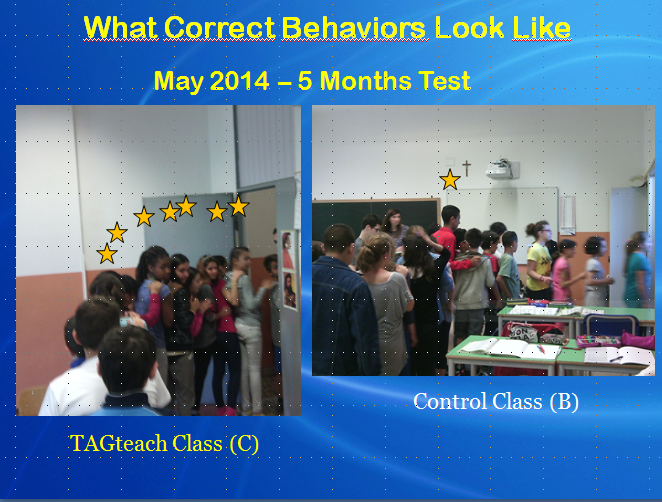By Luca Canever, Elisa Casarini and Eleonora Galanti
Canever, L, Casarini, F. and Galanti, E. (2014) The Effects of Using TAGteach to Promote Earthquake Safety for Children in School. Presented at the 7th Conference of the European Association for Behaviour Analysis. University of Stockholm. Stockholm, Sweden. Sept 10-13, 2014.
Read Abstract: http://www.europeanaba.org/events/submission/7/62
Obviously, the more you train the more skilled you get, or at least, you should get. We wished to find out if, given the same amount of training time, using an event marker (like the box clicker we use in TAGteach) could make any difference in terms of learning quality. We wished to find out if a marker based teaching could be a more effective way to improve learner’s retention, endurance and application of new skills.
Retention, endurance and application are, according to C. Binder the indexes for how well we are in doing something and how skilled we are in always performing a task quickly and correctly.
- Retention and maintenance of skills and knowledge is the index of how we remember a learned skill. For example most of us have high retention in riding a bicycle.
- Endurance or resistance to distraction is the index of how easily we can perform a learned skill. If I can perform a given behavior effortlessly it will be easier to repeat this even in more challenging environments. We shouldn’t but we can drive a car AND speak to the cell phone.
- Application or transfer of training: Once we master a skill we can easily apply it into other context. Learning to swim in a swimming pool is helpful to swimming into the sea.(C: BINDER (1993), Behavioral Fluency new paradigm)
We tested the effects of a TAGteach-based procedure to train safety behavior in case of earthquake for children in a primary school in Italy. We also compared this teaching technique with the traditional lecture + practice protocol. Participants were first grade students of four classes in a public secondary school (aged 11). A national mandatory protocol for earthquake safety in public buildings was used for the training. Two groups were taught with a traditional method and two groups were taught with TAGteach. The dependent variables for this study were the percentages of correct and incorrect behavior emitted by all the children during each earthquake simulation and the total time needed for the protocol execution (starting from the teacher giving the alarm signal to all children leaving the building and reaching a safe meeting place). Post-probe and follow-up data suggested that TAGteach can be an effective teaching strategy in order to increase retention and automatic execution of safety behaviors both immediately after the training and over time.
We had the chance to work with four classes. We trained and tested them right after the training and after 3 and 5 months. Consistently, the TAGteach classes were better, as illustrated in the graph below.
The three months test shows a huge difference between correct behaviors. In this test the correct behaviors exhibited by TAGteach Class equals the results of control class right after the training.
Overall the persistence of behaviors is more consistent and it looks like the use of TAGteach can improve the rate and the quality of the memorization of learned behaviors. The students perform better and remember better.
One teacher who took part to the research (she was one of those who taught the protocol in one of the control class) told me that during one of the tests the school runs during the year the TAGteach Classes were far more better than the others.
Apparently it’s the use of TAGteach as a positive-marker based methodology that improves the quality of student’s performance.
The marker delivers well timed positive feedback. Furthermore the TAGteach Methodology always focuses both teacher and student’s attention on something to do, not the contrary. Students are allowed to focus on what they should learn not on what they should avoid doing. In this way their memorization is helped because no useless information are given, and the retention of the learned behaviors improved.
Thanks to Elisa Galanti and Eleonora Casarini for writing the research with me. Thanks also to the School which hosted us, to the researchers who took the data and to the students.


